Facilities Completed Major Projects
Skip to Main ContentALIKI PERROTTI AND SETH FRANK LYCEUM
197 S. Pleasant Street
Completed 2023
The Aliki Perroti & Seth Frank Lyceum is the home of the Center for Humanistic Inquiry (CHI) and the History Department. In addition to faculty and staff offices, the Lyceum includes the CHI Think Tank, multi-purpose classroom and seminar rooms, and the History Commons. The Lyceum consists of a mid-18th-century former residence at 197 South Pleasant Street, which needed significant repairs, and a new addition to the south and west. The Lyceum is Amherst's first building designed with a goal of zero embodied carbon, with mass-timber framing and careful consideration of the carbon emissions associated with manufacturing and transporting materials. Solar photovoltaics and air-source heat pumps also make it one of the College’s most energy-efficient buildings and first all-electric building.
SCIENCE CENTER
25 East Drive
Completed 2018
The Science Center, which opened in the fall of 2018, provides state-of-the-art facilities and flexible spaces to support the sciences at Amherst. Located on the eastern side of campus on the Greenway, the Science Center houses the departments of Biology, Chemistry, Computer Science, Physics, and Psychology. The building features an open and welcoming central commons with a cafe, academic resource space, and a variety of classrooms. With a team of architects, engineers, and sustainability experts led by Payette, Amherst developed strategies for the building to perform at an ambitious level of energy efficiency, approximately one-quarter of the energy used by the average science building per square foot. The focus on energy performance addressed everything from the building HVAC down to individual lab hoods, a state-of-the-art insulating building envelope, solar photovoltaics, a green roof, daylighting, and floor-plan design that groups sensitive and specialized lab systems. The Science Center has won national awards including the 2022 AIA Interior Architecture Award and the 2019 AIA Committee on the Environment Top Ten Award.
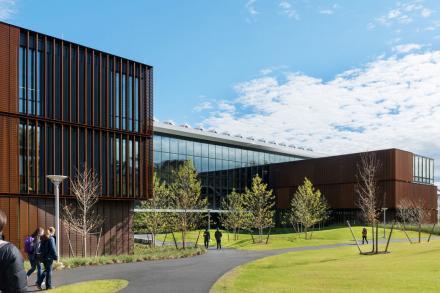
FORD, LEE, GREENWAY C, AND NICHOLS BIONDI HALLS (GREENWAY RESIDENCE HALLS)
Merrill Science Drive
Completed 2016
The four Greenway Residence Halls, designed by Kyu Sung Woo Architects, house approximately 300 students in a variety of room types, from singles to suites. Large windows showcase incredible views to the south while providing passive solar heating, and the four buildings feature a variety of community spaces such as two-story study areas, connecting bridges, kitchens, a multi-purpose event space, and seminar/meeting rooms. The design of the Greenway Residence Halls addressed energy and water consumption comprehensively, with features such as heat recovery for ventilation air, drain heat recovery of domestic hot water, and a rainwater harvesting system that supplies toilets, in addition to conventional sustainability strategies such as high-performance windows and low-flow fixtures. To further foster community and connect to the larger Greenway area, the landscape design included new pathways, lawns, plantings, volleyball and basketball courts, a barbeque area, and a gathering/performance amphitheater.
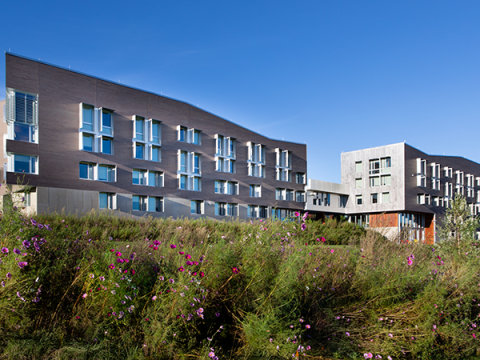
POWERHOUSE RENOVATION
10 East Drive
Completed 2014
Originally designed by McKim, Mead and White—designers of Fayerweather Hall, Chapin Hall and the Mead Art Museum—the Powerhouse served as the College’s first centralized steam plant, housing coal-fired boilers. It remained in use until the 1960s, when the College built a modern gas- and oil-fired steam plant. After this, the Powerhouse was underutilized as a garage. The College hired Bruner/Cott to convert the Powerhouse into a space for student use. A raw industrial, modern space now provides ample volume for gatherings, dances, parties, a cappella rehearsals and other live performances, catered dinners and receptions, student meetings, art exhibits, coffeehouse evenings, panel discussions, pub nights, outdoor barbecues, movie screenings, and farmers’ market and food truck nights. The flexible volume allows for many possibilities and changes over time. The space flows to an exterior courtyard through large openings, including a glass vertical bi-fold bay doors. The Powerhouse renovation received many awards, including a 2017 Paul & Niki Tsongas Award, considered the most prestigious honor for architectural preservation in Massachusetts.

79 SOUTH PLEASANT STREET
Completed 2013
A historic building originally built in 1834 as First Baptist Church, 79 South Pleasant Street on the Town Common was updated and expanded to house the Five College Center for the Study of World Languages along with a few of Amherst College’s administrative departments. Designed by Kuhn Riddle Architects, the renovation and addition gives a careful nod to the historical importance of the building and its contemporary context while reinvigorating its presence on the Town Common.
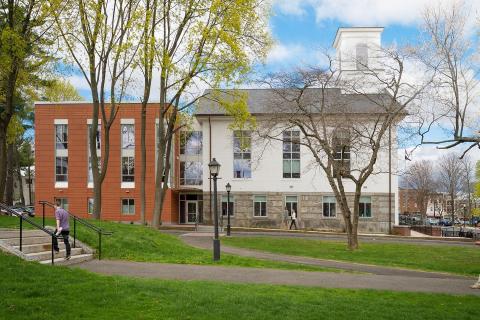
PRATT FIELD FACILITIES
Completed 2013
This project included a new Pratt Field, Lumley Track, athletics building, press box and grandstands. Upgrades included a new artificial turf, track accommodating NCAA events and lighting for night games. The project was extremely expedited, going from an idea to kickoff in a completed stadium in only 18 months.
HITCHCOCK HOUSE
Completed Spring 2013
This project included an energy retrofit; installing heat pumps for heating and cooling, added insulation in the attic and basement, changing the lighting and installing efficient equipment.
SELIGMAN HALL RENOVATION & ADDITION
Completed 2013
The 2013 gut renovation and addition to Seligman was its first major renovation in the building’s 80-year history. The renovation maintained much of the existing character of the building including exposed wooden beams and fireplaces while improving accessibility and common space functions. The addition doubled the building’s bed count while adding a study space and kitchen area.
INN ON BOLTWOOD RENOVATION
30 Boltwood Ave
Completed 2011
The Inn of Boltwood is a historic hotel owned by Amherst College that originally opened in 1926 and faces the Town Common. The 46,000 square-foot building required a complete gut renovation and was restored with historical detail that earned the project national, state and local awards including from Historic Hotels of America, Amherst Historical Commission, and Massachusetts Historical Commission. The renovation included all new furnishings and amenities in the 49 renovated guest rooms and suites, updated and expanded conference and function facilities, a full service restaurant and modernized utilities. Among other sustainability features, the Inn was Amherst College’s first use of a ground-source heat pump technology to provide the most energy-efficient option for heating and cooling.
ADVANCEMENT PRECINCT
Completed 2010
Substantial renovations of Smith House and Pontypool House created new office space for the College’s Advancement Department.
ACADEMIC FACILITIES PLAN
Completed 2010
Shepley Bulfinch’s planning group led analysis of non-residential, non-athletic space allocation and utilization, projecting academic and administrative space needs and suggesting ways to optimize space use and increase long-term space efficiency.
SEELYE AND HITCHCOCK HALL RENOVATIONS
South Pleasant Street
Completed 2009
Seelye and Hitchcock, originally built in 1912 and 1927, were updated with high-performance building envelopes, high-efficiency mechanical and electrical systems. all while respecting their historic character. An addition more than doubled the number of student rooms in Hitchcock, and a new solar thermal system now provides most of the domestic hot water needs for Hitchcock.
CHARLES DREW AND MAYO-SMITH HOUSE RENOVATIONS
College Street
Completed 2008
Comprehensive renovations to Charles Drew and Mayo Smith were completed as part of the 2002 Residential Master Plan. Both buildings underwent envelope and structural repairs, and received new first-floor kitchens and laundry rooms. Energy-efficiency improvements included added insulation, heat-recovery ventilation, occupancy sensors for lighting, and high efficiency lighting. The Mayo-Smith renovation also reconfigured common space to add bedrooms within the existing footprint and added a solar-thermal hot water system to the roof.
COGENERATION PLANT
Completed 2008
The cogeneration plant was put in place in order to help reduce the campus’ carbon footprint, reduce fuel costs, and use less energy through the simultaneous production of electricity and heat. The plant reuses waste heat from combustion to produce steam.
CHARLES PRATT RESIDENCE HALL
Quadrangle Drive
Completed 2007
Following the opening of Beneski Hall, this comprehensive renovation and addition project converted the former Pratt Museum and Geology Building into a residence hall for over 100 first-year students. The design of both the interior and exterior highlights the historic character of the building.
HAMILTON & PORTER HOUSE RENOVATIONS
College Street & Boltwood Avenue
Completed 2007
Comprehensive renovations preserved the original aesthetics of these buildings while updating all aspects utilities, access, life-safety, interiors and exteriors.
BENESKI EARTH SCIENCE AND MUSEUM OF NATURAL HISTORY
Barrett Hill Road
Completed 2006
The home of the Department of Geology and the Museum of Natural History contains teaching and research labs, faculty office and support spaces, a large lecture hall and the Beneski Museum. The 55,800-square-foot building designed by Payette pays homage to the strong design features of surrounding campus buildings – such as Fayerweather Hall – and has won several prominent architectural awards for aesthetics and technical design. Its design highlights the collaborative, interdisciplinary nature of contemporary science and integrates the museum collections with the building’s classrooms and laboratories.
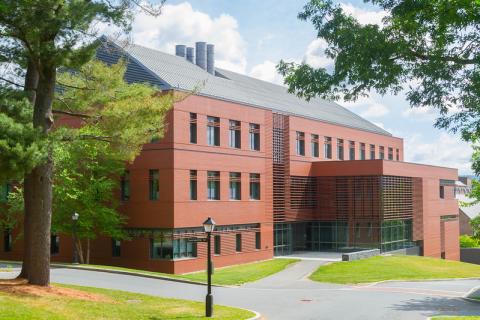
MORRIS PRATT & MORROW HALL RENOVATIONS
Pratt Quad
Completed 2006
As part of the Residential Master Plan, this project addressed the pressing needs to improve sophomore housing on campus. Comprehensive renovations updated the layouts of the buildings, exterior envelope, physical accessibility, and all mechanical/electrical/plumbing systems.
JAMES & STEARNS HALLS
Main Quad
Completed 2005
These two residence halls, occupying a prominent position at the heart of campus, were constructed to house first year students while maintaining the historic character of the First-Year Quad. James and Stearns replaced residence halls of the same names originally built in 1946. Built within the footprints of the former buildings, the new James and Stearns provided higher ceilings, lighter spaces, and new house lounges and libraries to provide informal, comfortable social space.
NORTH COLLEGE/SOUTH COLLEGE RENOVATION
Quadrangle Drive
Completed 2004
This comprehensive renovation project included a complete redesign of the interiors as well as a historically sensitive restoration of the exteriors of Amherst’s oldest buildings.
WIELAND & KING HALLS
Merrill Drive
Completed 2004
These two new residence halls built to provide housing for 115 students are modern, yet reminiscent of the simple Puritan buildings of historic College Row. The buildings’ relatively small floor plans, with a maximum of 15 single-occupancy rooms on a floor, are designed to encourage community, as are ample common rooms and living areas on the ground level. When constructed, King and Wieland anchored the eastern edge of campus and created a transitional area between the traditional campus and athletic fields, an area that is now activated by the Science Center and Greenway Residence Halls.
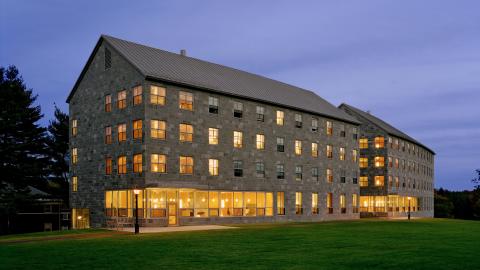
WILLISTON HALL RENOVATION
Quadrangle Drive
Completed August 2003
Williston was the first residence hall t to be completed under the College’s Residential Master Plan. A former classroom building, Williston was renovated to become the College’s seventh first-year residence hall and brought modern amenities to one of Amherst’s most historic buildings. Most of the original structure was removed and rebuilt within the original historic masonry shell.
JAPANESE GARDEN, YUSHIEN
Between Kirby and Webster Halls
Completed September 2002
This garden was designed and installed in recognition of the special relationship between Doshisha University and Amherst College.
COOPER HOUSE RENOVATIONS
College Street
Completed September 2002
Comprehensive renovation and new addition, including all new electrical and mechanical systems, a new roof, new windows, and a reconfiguration of the interior spaces were done to this former residence to allow Black Studies and Philosophy Departments to move in. The historic character of the original building was enhanced through attention to detail.
RESIDENTIAL MASTER PLAN
All Campus
Completed 2002
The Residential Master Plan was a two-year effort, completed in 2002, to analyze Amherst College's residential program and map the future of facilities. This plan generated a course of action to improve the campus residential environment in response to current and future needs and preferences in student living.
FAYERWEATHER HALL RENOVATION
Barrett Hill Road
Completed 2002
The renovations to Fayerweather Hall included state-of-the-art studios, classrooms, a lecture hall for 80, and new spaces devoted to fixed image study and a second 2D studio. Fayerweather now accommodates a more spacious Eli Marsh Gallery in the northwest corner, and two galleries in expanded hallways built along the "hyphen" that links its two wings.
MEAD ART MUSEUM RENOVATION
Quadrangle Drive
Completed 2000
Mead Art Museum had significant renovations that include the construction of new class and office space, a new teaching gallery and major enhancements in storage and infrastructure. The interior renovation of the building includes new heating, air-conditioning and ventilation systems to bring the museum up to national professional standards in the galleries, storage and art preparation areas.